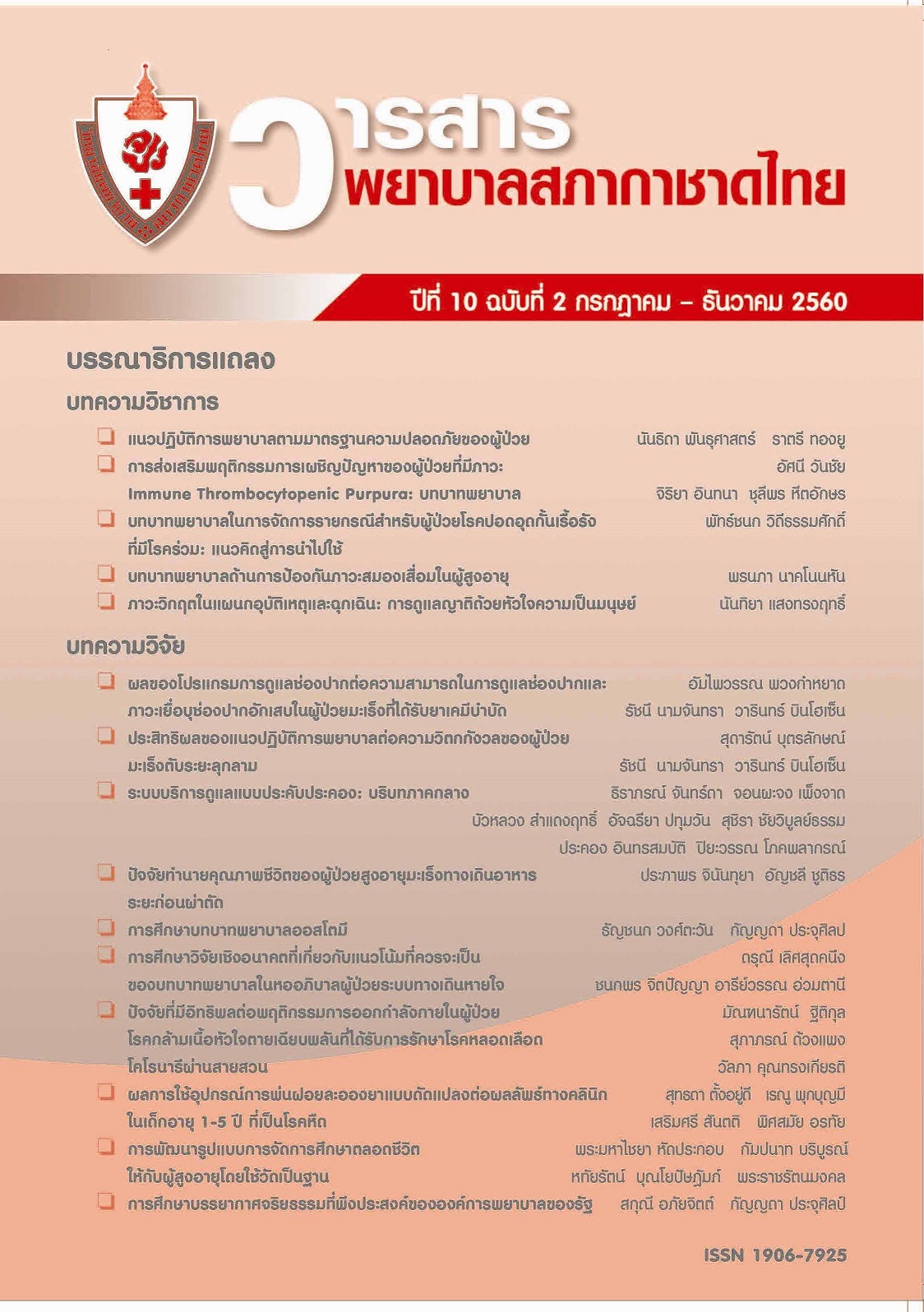Palliative Care System: Central Region of Thailand
Keywords:
ระบบบริการดูแลแบบประคับประคอง, บริการดูแลแบบประคับประคอง, การดูแลแบบประคับประคอง, palliative care system, palliative care service, palliative careAbstract
การวิจัยเชิงคุณภาพนี้ศึกษาระบบบริการดูแลแบบประคับประคองในเขตภาคกลาง เก็บข้อมูลโดยการสนทนากลุ่มและสัมภาษณ์เชิงลึก ทีมผู้ดูแล ได้แก่ แพทย์ พยาบาล เภสัชกร นักสังคมสงเคราะห์ เจ้าหน้าที่พยาบาล อาสาสมัคร และนายกองค์กรบริหารส่วนตำบล จำนวน 116 คน วิเคราะห์ข้อมูลโดยการวิเคราะห์เนื้อหา พบว่าระบบบริการดูแลแบบประคับประคอง ประกอบด้วย 3 ส่วน คือ 1) โครงสร้างระบบบริการ ได้แก่ นโยบาย ทีมบุคลากร การพัฒนาบุคลากร งบประมาณ ประเภทบริการ อุปกรณ์การดูแลและแหล่งสนับสนุน และระบบสารสนเทศ; 2) บริการสุขภาพด้านการดูแลผู้ป่วยแบบประคับประคอง ได้แก่ การเข้าถึงบริการและกิจกรรมบริการ กระบวนการดูแล ระบบส่งต่อ และการดูแลที่บ้าน; 3) ผลลัพธ์ของบริการดูแลแบบประคับประคอง ได้แก่ ผู้ป่วยได้รับการดูแลต่อเนื่องสมศักดิ์ศรี มีคุณภาพชีวิตที่ดี ครอบครัวได้รับการสนับสนุนและพึงพอใจกับบริการที่ได้รับ บุคลากรสุขภาพทำงานร่วมกันพัฒนาระบบการดูแล ได้รับการพัฒนาความรู้และทักษะการดูแล มีความสุขในการทำงาน โรงพยาบาลสามารถส่งต่อผู้ป่วยกลับบ้านได้มากขึ้น อัตราการครองเตียงลดลง มีการทำงานเป็นเครือข่ายมากขึ้น และมีสัมพันธภาพที่ดีกับหน่วยงานในชุมชน ข้อเสนอแนะการพัฒนาระบบบริการโดยจัดระบบบริการดูแลระยะยาว (long term care) ให้ครอบคลุมการดูแลแบบประคับประคองที่บ้าน จัดสิทธิประโยชน์ให้ครอบคลุม พัฒนาศักยภาพของทีมดูแลอย่างต่อเนื่อง พัฒนาระบบยาแก้ปวด ระบบการบริหารจัดการอุปกรณ์ ปรับปรุงระบบสนับสนุน ทำงานกับเครือข่ายเพื่อให้เกิดความต่อเนื่องในการดูแล
Palliative Care System: Central Region of Thailand
This qualitative study aimed to describe the palliative care system in the central region of Thailand. Focus group and in-depth interviews were employed to collect data from a palliative care team of 116 comprising physicians, nurses, pharmacists, social workers, care assistants, volunteers, and sub-district administrators. Content analysis was utilized revealing three parts of the health service system in palliative care: 1) The system structure comprises health policy, palliative team, funding, types of service, equipment and support, and information system; 2) Palliative care services involve access to service, care process, referral system, and home care; and 3) Outcomes of palliative care service include patients receiving continuous care until dying and having good quality of life; family receiving support and satisfied with the service; health personnel working as a team, creating care system, improving knowledge and skills, and happy with work; and hospitals increase the number of home discharge, decrease the duration of stay, working with network, and have a good relationship with the community. Suggestions for improving palliative care services include integrated palliative care in the long term care service, revising health coverage, improving palliative team competency, improving the pain medication system, managing equipment, improving the support system, and working with the network to expand continuous care.
Downloads
Published
Issue
Section
License
เนื้อหาบทความหรือข้อคิดเห็นต่างๆ ในวารสารพยาบาลสภากาชาดไทยนี้ เป็นความคิดเห็นของผู้เขียนบทความ ไม่ใช่ความเห็นของกองบรรณาธิการ หรือสถาบันการพยาบาลศรีสวรินทิรา สภากาชาดไทย






